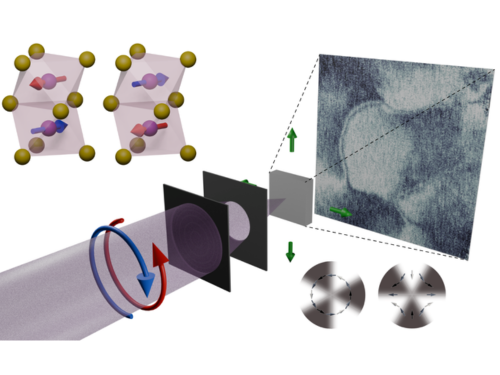Inquiries on the study
Rikako Yamamoto
Researcher
International Institute for Sustainability with Knotted Chiral Meta Matter (WPI-SKCM2), Hiroshima University
E-mail: ryama * hiroshima-u.ac.jp
(Note: Please replace * with @)
Inquiries on the story
International Institute for Sustainability with Knotted Chiral Meta Matter (WPI-SKCM2), Hiroshima University
wpi-skcm2-outreach * ml.hiroshima-u.ac.jp
(Note: Please replace * with @)
Hiroshima University Public Relations Office
E-mail: koho * office.hiroshima-u.ac.jp
(Note: Please replace * with @)
An international team has provided experimental evidence of bulk altermagnetism in MnTe. Using resonant X-ray nanoimaging, they resolved magnetic domains and confirmed their altermagnetic nature, establishing a powerful tool for future 3D and real-time studies of magnetic textures.

Schematic of X-ray magnetic circular dichroic scanning transmission x-ray microscopy, with the experimentalobservation of altermagnetic domains and topological nanotextures in MnTe. (Courtesy of MPI CPfS/C. Donnelly)
Magnetic materials have been known since ancient times and play an important role in modern society, where the net magnetic order offers routes to energy harvesting and data processing. Indeed – it is the net magnetic moment of ferromagnets that has so far been key to their applications, with an alternative type of magnetic material, the antiferromagnet, deemed “useless” by their discoverer Louis Néel in his Nobel Prize lecture. In recent years, there has been increasing interest in antiferromagnets, which offer a number of exciting advantages for technologies including robust order and ultrafast dynamics – however with the challenge that they are hard to detect and manipulate electrically. The recent discovery of a new type of magnetic order – the altermagnet – has overturned this view: by combining antiferromagnetic ordering with ferromagnet-like properties such as spintronic effects, they promise a multitude of advantages for future applications.
Since the first theoretical works predicting altermagnetism, the field has grown rapidly, with both theoretical and experimental works leading to advances in our understanding. One of the questions that remained, however, was the bulk nature of the order, and whether this could be measured experimentally. Indeed, with most previous experimental studies making use of thin films, or techniques that are intrinsically surface-sensitive, the question remained as to how the altermagnetic properties manifest through the bulk of a material. To address this challenge, an international research team led by Claire Donnelly at the Max Planck Institute, who is also a Principal Investigator at the International Institute for Sustainability with Knotted Chiral Meta Matter (WPI-SKCM2) at Hiroshima University, performed scanning transmission X-ray microscopy (STXM) measurements with nanoscale spatial resolution on lamellae extracted from a single crystal. Excitingly, in this way they were able to successfully observe altermagnetic domains in bulk samples of MnTe—a candidate altermagnet—that up until now had only been seen in thin film systems.
These X-ray measurements not only allowed the team to observe the magnetic configuration – but by performing them as a function of X-ray energy, they were able to address outstanding questions about the altermagnetic nature of the material. “In previous measurements published by our colleagues, the measured X-ray dichroism was significantly weaker than had been predicted by theory” says Rikako Yamamoto, postdoctoral fellow at the Max Planck Institute for Chemical Physics of Solids and WPI-SKCM2, and first author of the study. “But when we compared our results, we saw that the signal strengths matched the theory almost perfectly – allowing us to confirm that the bulk of our sample is altermagnetic!”.
The experiments were conducted at the MAXYMUS beamline of the BESSY-II synchrotron in Berlin. In the experiment, circularly polarized X-rays were focused down to a nanoscale spot size, and scanned across the sample, with the transmitted signal measured for different polarizations. This so-called “X-ray magnetic circular dichroism” is most commonly associated with ferromagnets, where the signal corresponds to a net magnetic moment, but is typically zero in antiferromagnets, where the net magnetization vanishes. Altermagnets, on the other hand, do exhibit this X-ray dichroism, despite their antiferromagnetic order, which offers a route to mapping their properties on the nanoscale.
“What was particularly interesting was the variety of features we observed in the X-ray dichroic images” said Donnelly, “as well as observing bright and dark regions which correspond to regions of different orientations of the altermagnetic order, we also saw a number of nanoscale features with more complex patterns”. Indeed, dichroic signals suggestive of topological structures were observed, including both domain walls and winding, vortex-like textures. “The fact that such structures could be seen in naturally grown single crystals was surprising!” continued Yamamoto, “This hopefully means that this approach can also offer a platform for exploring topological magnetic textures – and how they behave!”
This study not only provides experimental evidence for the bulk nature of altermagnetism in MnTe, but also establishes transmission X-ray nanoimaging as a powerful method for identifying altermagnetic order. Going forward, the approach can be readily applied to many other candidate altermagnets, which are being predicted by theorists. Marcus Schmidt, scientist at the Max Planck Institute for Chemical Physics of Solids, who grew the single crystal MnTe explained “the fact that we can now grow these materials, and directly probe their altermagnetic order on the nanoscale with X-rays is very exciting – who knows what we will find!”
About the study
Journal: Physical Review Applied
Title: Altermagnetic nanotextures revealed in bulk MnTe
Authors: Rikako Yamamoto, Luke Alexander Turnbull, Marcus Schmidt, José Claudio Corsaletti Filho, Hayden Jeffrey Binger, Marisel Di Pietro Martínez, Markus Weigand, Simone Finizio, Yurii Prots et al.
DOI: 10.1103/dp7v-qszq

 Home
Home














